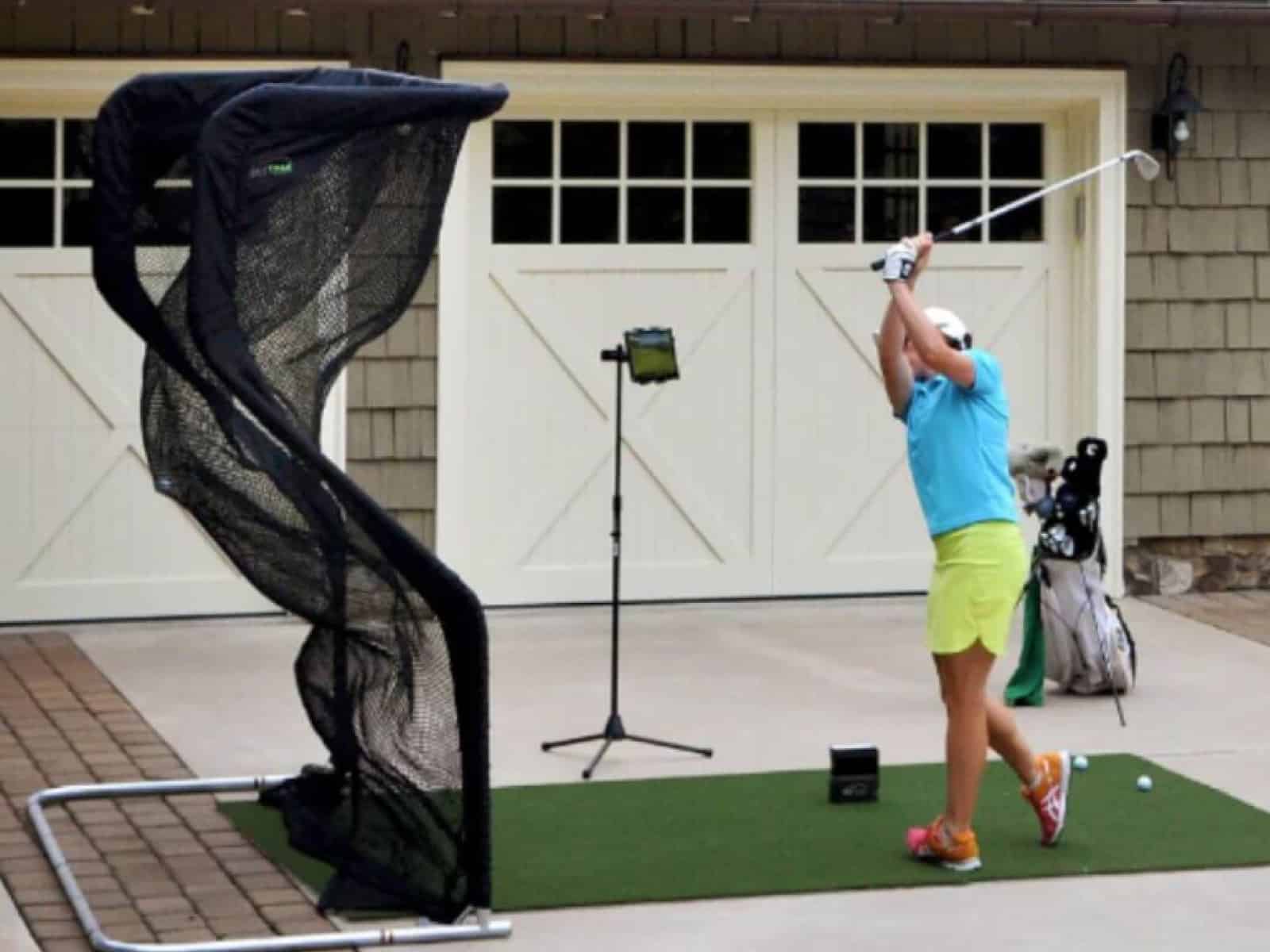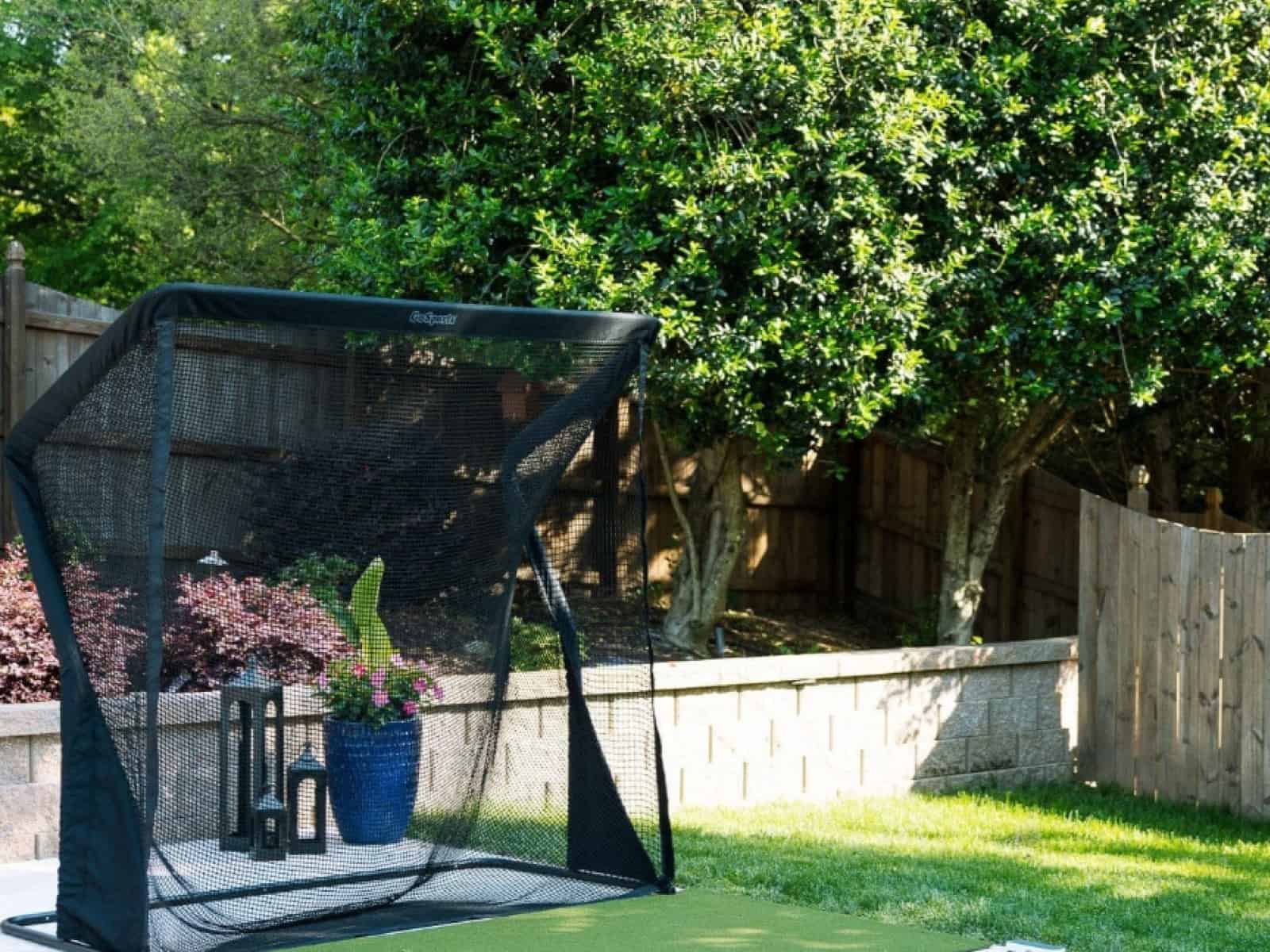When setting up a golf simulator in your home, garage, or dedicated space, two key options emerge: constructing a full deep cage enclosure around the simulator, or simply using a basic screen with curtains. There are several key factors to weigh when deciding between these setup choices. The visual immersion, playability, and performance can vary greatly depending on decisions around enclosing the physical setup.
The deep cage option provides a fully enclosed space with a ceiling and walls around the sides and back of the simulator area. Screens and curtains simply place a basic display screen or net in front of the hitting area with open sides.
So, how do you choose between the two configurations? That’s exactly what we’ll be answering through this article. By the end, you will have more information about deep cages vs. screen/curtain combos.
Key Factors to Consider
Before making your final decision, there are a few factors to consider to ensure you make the best choice possible; these include budget, simulation accuracy, safety and protection, and installation and maintenance.
Carefully weighing these initial factors provides a starting point for determining the best golf simulator configuration for your individual needs and space. These factors, as well as others, will be discussed individually, in more detail, in the upcoming sections. A comparison of the two configurations based on each factor will also be provided.
Cost and Budget

When selecting either a full enclosure or basic screen and curtain golf simulator configuration, cost considerations come strongly into play. Constructing deep cages requires a major upfront investment that can pay dividends long-term if properly protecting higher-end equipment.
Deep Cage Enclosure Costs
Building a custom deep cage enclosure requires a significant expenditure on materials, construction labor, required permits, and installation around existing space and layouts. Costs typically start around $10,000 at minimum, ranging up to $30,000+ for larger multi-bay professional installations.
Factors impacting total expense include:
- Enclosure dimensions and materials
- Accessories like doors, flooring, lighting, and soundproofing
- Construction complexity around existing infrastructure
- Local labor and permit costs
While expensive initially, full enclosures provide long-term protection and durability for the space as discussed in later sections.
Screen and Curtain Costs
A screen and curtain configuration has relatively low material and installation costs. Screens, impact netting, projector stands, and rails for curtains generally total less than $3,000 altogether.
Labor is also minimal for installation compared to custom cage building. Fasteners, cables, and simple framing are simpler for getting a basic simulator hitting area ready for play.
Operating Cost Differences
Over time, the expense gap can narrow given the durability and equipment protection aspects of enclosures. Replacing damaged equipment or projector bulbs prematurely due to dust or impact incurs regular maintenance fees.
Deep cages prevent such harm, allowing for reliable ongoing use of golf simulator equipment. So while basic curtains provide huge upfront savings, they present higher long-term operating costs and risks.
Simulation Realism and Immersion

A core goal of any home golf simulator is creating an immersive, realistic environment that transports you onto famous courses. The enclosure versus basic curtain decision significantly impacts the visual and audio fidelity.
Visual Immersion Benefits of Enclosures
Full deep cage enclosures allow you to fully control lighting conditions. This optimizes projector visuals, contrast ratios, and color reproduction. Ball flight simulation only appears realistic with optimal lighting directed at the screen.
Enclosures also prevent outside light from interfering with projection quality. Ambient lighting shining directly on basic curtain setups washes out images.
When constructing your own golf simulator, selecting the optimal enclosure is crucial for protection, lighting control, and long-term reliability. You can check our golf simulator screens and enclosures guide to discover the ideal framework for your space.
Curtain Limitations for Immersion
While curtain systems cost less upfront, they sacrifice immersive realism. Projectors may struggle with ambient sunlight or indoor lighting shining directly on the hitting area and screen.
Shadows can also be cast across the mat and displayed images depending on the direction of outside light sources. This affects the realistic visuals required for proper swing adjustments and training.
Sound Considerations
Enclosures allow supplementary speakers and sound insulation materials to enhance the auditory experience. The cage contains and amplifies impact sounds from club to ball.
Comparatively, basic curtain solutions provide no acoustic treatment. Swing sounds compete with household noises and lack a feeling of depth. Environments sound hollow rather than transporting golfers onto the course.
In summary, deep cages better immerse golfers into a dedicated simulation space through advanced lighting, video, and audio control.
Playability and Performance
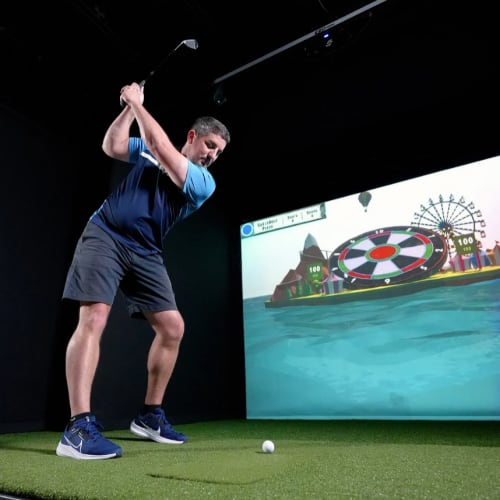
Serious golfers prioritize both playability and overall system performance when evaluating home simulator configurations. Enclosed cages and basic curtains each impact factors like swing plane restrictions, simulation accuracy, and repeatable ball striking.
Cage Size Limitations on Swing
While protective of equipment, deep enclosures can limit complete freedom of movement during practice swings and full shots. Ceiling height, width, and depth must provide ample room for a golfer’s personalized swing plane angle and width requirements.
Insufficient dimensions lead to contacting cage framework, limiting the swing and degrading simulation precision from inconsistent ball-striking. Multi-bay commercial enclosures mitigate this by allowing appropriate spacing.
Screen and Curtain Flexibility
Basic solutions (screen & curtain) provide wide-open sides that allow complete freedom to swing normally. Surrounding impact netting or safety padding contains mishits rather than restricting natural mechanics.
The spaciousness leads to more flexibility experiencing custom club fittings as well. Openness can encourage focus, rhythm and consistent ball-striking.
Simulation Accuracy Factors
Despite the freedom of swinging more naturally, basic curtain setups exchange flexibility for decreased simulation precision if ambient lighting washes out the visuals. Inconsistent ball speeds and launch angles lead to faulty shot data.
While enclosed cages can limit swing planes, lighting control promotes reliable sensor feedback. So optimal configurations balance sufficient swing space with dark lighting requirements.
Safety and Durability

Golf simulator configurations also differ drastically in durability, protection, and overall safety for people and equipment. Enclosed cages strongly protect from damage while basic curtain solutions leave simulators exposed.
Deep Cage Protection
Full metal and netting surrounding a simulator form reliable barriers protecting all equipment. wayward shots simply rebound away rather than causing any harm.
Enclosures also prevent dust accumulation on sensitive components compared to open air configurations. Preventing debris promotes long-lasting lasers, sensors, lighting, and projectors.
For multi-user facilities, solid barriers also protect people outside the bays from being inadvertently struck by hooks or slices.
Exposure Issues with Curtains
Basic screen and rail configurations provide no protection against missed shots. Projectors, impact sensors, and other critical gear stay vulnerable to damage over time.
Open sides also allow dust, debris and moisture to gradually reduce component lifespans. Yearly costs grow compared to protected enclosures designed to last decades without issue. Another concern is safety for bystanders with loose netting instead of hardened walls quarantining hooks and slices. Carefully weigh risks and potential costs before selecting curtains to save money initially.
Installation and Maintenance
Installing and maintaining your preferred golf simulator configuration carries stark differences in complexity between enclosures and basic curtains. Constructing deep cages requires major legwork compared to plug-and-play screen solutions.
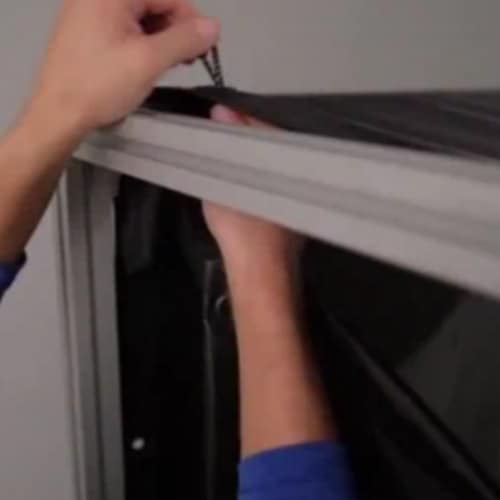
Deep Cage Installation Complexity
Full enclosures demand extensive planning around sizing, layout, materials, permitting, and integrating with a home’s infrastructure. Significant coordination with contractors occurs in mapping needs around existing walls, electrical, and other utilities.
Specialized knowledge is required for properly calibrating simulator tech like lasers, sensors, projectors, and hitting mats within the space as well. This further complicates installation.
Following construction, initial calibration and tuning ensure optimal simulation accuracy before enjoying the new simulator. Patience pays off long-term, though.
Screen and Curtain Ease of Installation
Alternatively, basic screen and curtain solutions fasten into place without concern to enjoy simulated virtual courses and work on ball flight characteristics. Easy power hookups and basic projector positioning get systems functional very quickly.
While lacking immersion cues, hurried installations foster rapid trials giving basic feedback on clubs and swing adjustments. Simplicity allows shifting configurations to refine over time.
When selecting your screen and curtain materials, durability and performance are key considerations. Checking our in-depth guide on the best golf simulator curtains will ensure you choose options tailored to your climate, space, and hitting intensity.
Maintenance and Repairs
Protected deep cage enclosures minimize servicing sensors, projectors, screens, or other hardware once fully enclosed. Components stay secure from damage while blocking dust infiltration.
However, exposed curtain configurations often require replacing or recalibrating sensitive elements damaged by debris or miss-hits over time. Yearly operating costs exceed caged simulators as repairs accumulate.
So, major initial installation efforts of deep cages reward owners over years of reliable operation. Basic curtain solutions provide instant gratification but could accumulate maintenance fees.
Summary & Recommendations Based On Needs
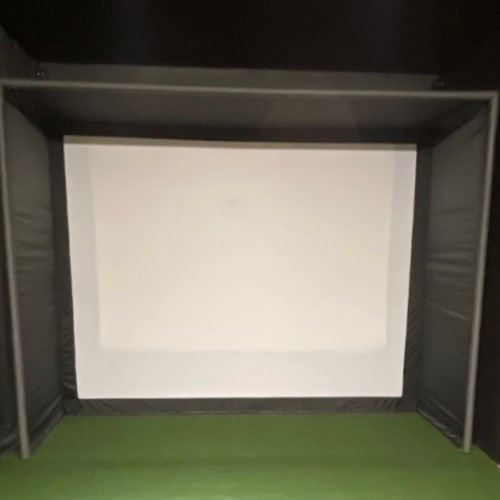
Enclosed cages provide superior lighting control, protection, and durability, safeguarding valuable simulator components. However, deep cages restrict swing planes occasionally and involve major upfront construction costs.
Basic screen and curtain solutions cost significantly less to purchase and install rapidly, but they may sacrifice simulation accuracy when ambient lighting washes out projectors. Openness also leaves expensive gear vulnerable over years of use.
There is no universally superior option. Needs and constraints dictate the best direction.
For those prioritizing cost-savings and rapid practice with basic feedback, basic screen and curtain solutions suffice. Start slowly before investing further over time.
Avid golfers focused on highly accurate swing analysis, visual immersion, and long-term reliability should construct protected enclosures despite the complications. They dedicate the space for better training.
Casual players may sit in the middle, weighing affordability against durability to strike the right balance. Custom netting and padding can help too.
Carefully analyze needs against costs when selecting between enclosure and curtain golf simulator configurations. And don’t be afraid to reassess and change approaches later on as well.
Frequently Asked Questions
The following are some of the most frequently asked questions answered to help you further understand the topic and make an informed decision.
Can I install a basic simulator screen myself?
Yes, basic screens use simple hardware for rapid DIY installation. Enclosures usually require construction experts because of the exact measurements that need to be considered.
Will cage size limit my swing plane and mechanics?
Potentially, if dimensions are insufficient, any configuration can limit your swing plane and mechanics. Try to allow 2 to 3 feet of clearance in all directions.
How often will I need to replace equipment with basic curtains?
Factor in replacing bulbs, sensors or other hardware every 2-3 years from miss-hits potentially causing damage to your equipment.
Can I add enclosure walls over time to a basic screen?
Yes, absolutely; modular panels can convert basic screens into partial or full cages down the road.
What steps can help optimize lighting conditions?
To optimize lighting conditions within your golf simulator space, blackout shades on windows and dark paint colors will help prevent light from washing out the projected visuals.
Final Thoughts
As discussed earlier, when weighing whether to construct a full deep cage enclosure or a basic screen and curtain for your home golf simulator, there are trade-offs to consider around budget, performance, realism, and long-term reliability.
If you’re interested in constructing your own golf simulator enclosure but are unsure where to start, check our guide on how to build a golf simulator for step-by-step advice tailored to your space and budget.
If you have any other questions or comments, feel free to contact us via the comments section below or by email. We will be happy to assist you the best we can.
Thanks for reading!


